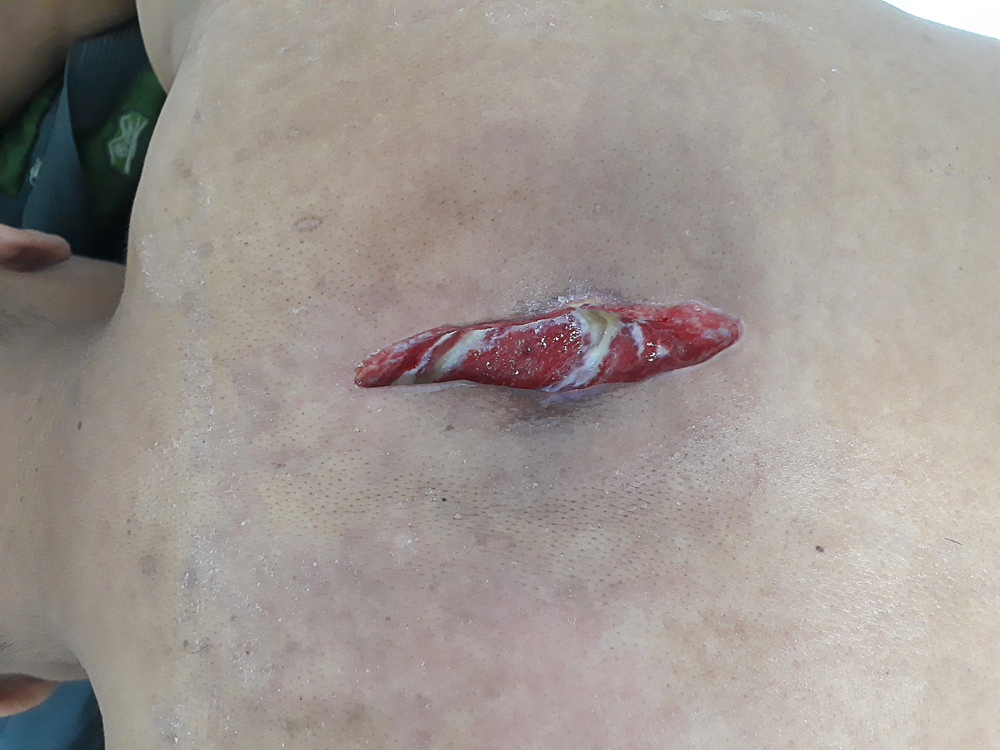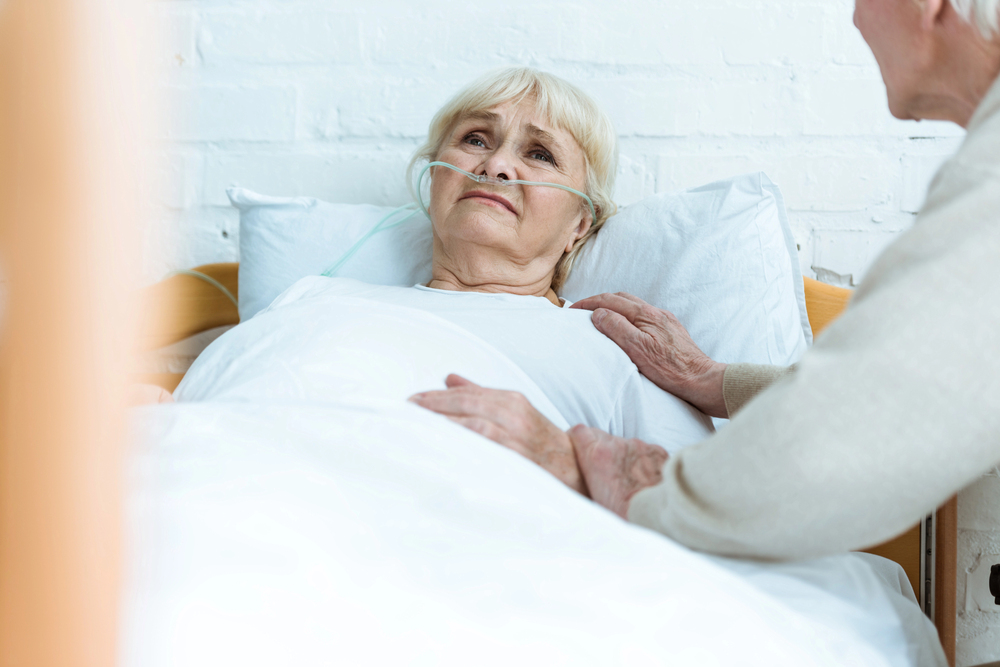The Nursing Home Law Center is committed to providing the legal resources necessary to hold negligent facilities accountable.
Bed Sore Symptoms
Early recognition of bed sore symptoms is critical. Bed sores—also called pressure ulcers, sores, or injuries—are usually preventable with proper care. Yet in many nursing homes, families don’t find out until the wound is advanced, infected, or life-threatening.
These injuries develop from prolonged pressure on the skin, especially when caregivers fail to change position, keep the skin clean, or monitor early signs of skin and tissue damage.
This guide explains each stage of symptoms so families can act quickly and learn how to seek compensation with the help of a nursing home bed sore lawyer if neglect has caused avoidable harm.

What Are Bed Sores and Why Do Symptoms Matter?
Bed sores are more than just painful wounds—they’re often a sign that a vulnerable person isn’t getting the basic care they need. These injuries happen when pressure on the skin cuts off blood supply, damaging the tissue beneath. When staff fail to turn immobile patients or ignore early symptoms, pressure sores can quickly worsen.
Understanding and identifying symptoms of early is essential for treatment and uncovering possible nursing home neglect. In many cases, these wounds are entirely preventable with routine care, and their presence may be a red flag that something is seriously wrong.
How Bed Sore Symptoms Develop in Nursing Homes
In nursing homes, bed sore symptoms often start minor, like slight redness or warmth over an affected area, but can quickly escalate if ignored. When residents are left in the same position for long periods, constant pressure on the skin reduces blood flow, leading to skin damage and deeper tissue injury.
Without early treatment, these sores can progress from minor irritation to open wounds, dead tissue, and deep infections. Facilities that fail to relieve pressure, monitor high-risk residents, or keep the skin clean allow these preventable injuries to grow worse, sometimes resulting in life-threatening complications.
Color Changes
One of the first visible bed sore symptoms is a change in skin color over pressure points. In lighter skin, this may appear as redness that doesn’t fade when touched. In darker skin tones, it can look purple, blue, or even gray. These early signs often go unnoticed if staff don’t check carefully or aren’t trained to recognize symptoms across different skin colors.
Any persistent discoloration, especially over bony areas, can indicate reduced blood flow and the beginning of skin and tissue damage. Recognizing these changes early is essential to prevent deeper pressure ulcers from forming.
Texture and Temperature Changes
Changes in skin texture or temperature are early warning signs of developing pressure sores. Areas affected by prolonged pressure may feel swollen, unusually firm or soft, or noticeably warm to the touch. These subtle symptoms can signal underlying tissue damage and reduced blood flow, even before an open wound forms.
In a nursing home setting, staff should be trained to monitor these changes regularly, especially in residents with limited mobility. When these symptoms are overlooked, they can lead to advanced bed sores requiring painful treatment and a longer recovery. Early detection helps prevent serious skin breakdown and deeper injuries.
Pain
Bed sores can cause intense pain, even before there’s any visible skin damage. Residents may complain of discomfort or burning in areas where pressure on the skin is constant, such as the heels, hips, or lower back. In many cases, deep tissue is already injured beneath the surface, even if the skin looks intact.
Pain is a critical bed sore symptom, and when ignored, it may signal that caregivers are missing or dismissing early warning signs. Nursing home residents who are unable to speak due to health conditions or cognitive decline may express pain through restlessness or moaning.
Foul Odor and Drainage
A foul odor coming from a wound is a serious warning sign of infection in a pressure sore. As the tissue damage worsens, dead tissue may form, allowing bacteria to grow. This can result in pus-like drainage, discoloration, and a strong, unpleasant smell.
These symptoms often mean the body is struggling to fight off infection, and if left untreated, they can lead to sepsis, a life-threatening condition. When nursing homes fail to keep the skin clean, remove dead tissue, or provide timely care, they place residents at risk of serious harm that could have been prevented.
Pus, Fever, and Confusion
When a pressure ulcer becomes infected, the body often reacts with symptoms beyond the open wound itself. The presence of pus or thick drainage indicates a severe bacterial infection. As the infection spreads, residents may develop a fever, chills, or confusion—a common but often overlooked symptom in elderly individuals.
These signs can mean the infection enters the bloodstream, increasing the risk of sepsis or joint infections. At this stage, immediate medical care is critical. Delays in treatment or failure to recognize these bed sore symptoms may point to nursing home neglect and justify legal action.

Symptoms by Stages
Stage 1 Pressure Sores
Stage 1 pressure sores are the earliest form of skin damage and often the most overlooked. The skin remains intact at this point, but symptoms may include persistent redness, warmth, or firmness over a bony area. In residents with darker skin tones, discoloration might appear purple, blue, or gray instead of red.
The area may also be painful or itchy. These subtle changes are a response to prolonged pressure that restricts blood flow to the skin. If staff fail to relieve pressure or adequately monitor the affected area, this stage can quickly progress to an open sore. With proper care, Stage 1 sores can heal. When ignored, they may signal early neglect in the facility.
Stage 2 Pressure Injuries
Stage 2 pressure injuries involve visible skin damage, often presenting as a shallow open wound, blister, or scraped area. The outer skin (epidermis) has broken, and deeper tissue damage is beginning. Residents may feel pain or discomfort, and the area may be swollen, red, or leaking fluid.
At this stage, the body is highly vulnerable to infection if the skin isn’t kept clean or dead tissue isn’t managed. Staff should provide wound care, adjust positioning, and monitor closely. Failure to treat Stage 2 bed sore symptoms can result in worsening damage and possible joint infections, particularly in high-risk residents with fragile skin or poor nutrition.
Stage 3 Decubitus Ulcers
In Stage 3 decubitus ulcers, the injury extends through the skin into deeper tissue, forming a deep wound or crater. By this point, the sore has gone beyond the surface layers and may show signs of dead tissue, drainage, or foul odor. The affected area may look sunken and be surrounded by red or darkened skin.
Wound healing becomes more difficult as blood supply to the area is reduced, and the risk of infection increases significantly. These ulcers often require aggressive treatment, including cleaning, medication, and sometimes surgery to remove dead tissue. If caregivers fail to catch earlier stages, a Stage 3 wound often reflects ongoing neglect or poor facility protocols.
Stage 4 Pressure Ulcers
Stage 4 pressure ulcers are the most dangerous form of pressure injuries, with extensive tissue loss and exposure of muscle, tendon, or even bone. These wounds are often accompanied by pus, foul odor, and signs of systemic infection, such as fever or confusion. They may also result in joint infections, osteomyelitis, or sepsis, any of which can be life-threatening.
Wound healing at this stage is slow and may require surgical interventions like skin grafts. A Stage 4 ulcer typically forms only after prolonged pressure has gone unaddressed for an extended time. In nursing homes, this is a strong indicator of severe neglect, often justifying legal investigation and possible claims for damages.

Deep Tissue Pressure Injuries
Deep tissue pressure injuries are especially dangerous because they often develop beneath the skin before any visible signs appear. These injuries result from prolonged pressure that cuts off blood flow, damaging the underlying tissue even when the surface looks intact.
Early symptoms may include discoloration, especially in darker skin tones, along with firmness, swelling, or tenderness over the affected area. By the time the skin breaks, significant tissue damage may have already occurred.
Without prompt care to relieve pressure and support wound healing, these injuries can rapidly progress into severe bed sores, infections, or even permanent complications.
Unstageable Pressure Sores
Unstageable pressure sores are wounds that can’t be accurately classified because they’re covered by necrotic tissue, scabs, or thick slough that hides the full depth of skin and tissue damage. These sores may appear black, brown, or yellow and often produce a foul odor.
Until the dead material is removed—a process known as debridement—it’s impossible to determine how deep the injury goes. These wounds typically indicate prolonged pressure on the skin and a failure to provide proper care. If left untreated, they carry a high risk of infection, including joint infections and life-threatening complications like sepsis.
Symptoms Often Overlooked by Nursing Homes
In many facilities, early bed sore symptoms are missed or ignored, especially when staff fail to document changes or dismiss concerns. Warning signs like skin discoloration, swelling, or complaints of pain may go unrecorded.
Some nursing homes attempt to manage sores by applying bandages without thoroughly assessing or diagnosing the pressure injury. Others offer vague explanations or blame the resident’s health conditions, instead of addressing prolonged pressure or failure to change position.
These oversights allow pressure ulcers to worsen, delaying treatment and increasing the risk of serious complications that may result from neglect or inadequate care.
Location-Specific Symptoms to Watch For
Bed sores often form in areas where pressure on the skin is highest and blood flow is most easily restricted. Common sites include the sacrum (lower back), hips, heels, shoulders, and even ears, especially in residents lying in one position for long periods. These areas should be regularly inspected for redness, swelling, temperature changes, or signs of an open wound.
In residents with limited mobility or fragile skin, these spots are at high risk for pressure ulcers. Consistent monitoring is essential, as deep tissue injuries in these locations can quickly worsen if early bed sore symptoms are missed.
Symptoms Tied to Specific Health Conditions
Certain health conditions can make bed sore symptoms more severe or more challenging to detect.
Residents with diabetes may have reduced sensation, causing pressure ulcers to develop without noticeable pain. Those with paralysis or spinal cord injuries may not feel early signs like heat or pressure, leading to delayed treatment. Vascular disease can impair blood flow, slowing wound healing and increasing the risk of deep tissue damage.
These individuals require close monitoring and frequent position changes. When nursing homes fail to adjust care for these risk factors, even minor symptoms can escalate into dangerous pressure injuries.

Risk Factors That Make Symptoms More Severe
Certain risk factors can worsen bed sore symptoms and speed up the breakdown of skin and tissue. Weight loss, poor nutrition, and dehydration reduce the body’s ability to maintain healthy skin and slow wound healing. Residents who are immobile or confined to a bed or wheelchair are especially vulnerable due to continuous pressure on the skin.
Without interventions to relieve pressure and support hydration and nutrition, even minor redness can progress to a deep wound. Nursing homes must identify these risks early and adjust care plans accordingly. Ignoring them often leads to preventable, life-threatening injuries.
How to Monitor Symptoms at Home
Families can play a key role in spotting bed sore symptoms before they worsen. If a loved one is in a facility, routinely check common pressure points—like the lower back, heels, and hips—for changes in color, texture, swelling, or signs of an open wound.
Use a daily log to track observations and take clear photos of any suspicious areas. Document complaints of pain, odor, or drainage.
These records can help ensure proper treatment and may be vital if nursing home neglect is suspected. Early monitoring can make the difference between recovery and long-term skin and tissue damage.
When Symptoms Suggest Elder Abuse or Neglect
Some bed sore symptoms don’t just signal a medical issue—they may be signs of elder abuse or neglect. Unexplained wounds, rapidly worsening pressure sores, or complaints of untreated pain can indicate that staff are failing to relieve pressure, monitor the resident, or provide basic care.
If a resident develops deep wounds without documented treatment or staff offer vague or changing explanations, families should be concerned. Repeated signs of skin damage, poor hygiene, or lack of repositioning may point to serious care failures. In such cases, legal intervention may be necessary to protect the resident’s health and rights.
Skin Tearing or Fragility in Elderly Patients
In elderly residents, fragile skin can tear easily with even minor friction or movement—a condition known as skin shearing. These injuries often resemble early bed sore symptoms and may be mistaken for unrelated wounds. However, shearing is a warning sign that the skin can’t withstand prolonged pressure, increasing the risk of bedsores.
Without proper care, these small tears can evolve into open wounds or develop into full pressure ulcers. Nursing staff must take precautions such as using lifting devices, moisturizing regularly, and repositioning residents gently. Overlooking skin fragility is a common cause of avoidable tissue damage.
Wound Deterioration Despite “Treatment”
If a pressure sore continues to worsen despite reported care, it may be a sign that the treatment is ineffective or that proper care isn’t happening at all.
Ongoing tissue damage, increased drainage, or spreading redness often indicate inadequate wound assessment, lack of repositioning, or failure to remove dead tissue. In some cases, facilities may claim treatment is being provided, but no measurable healing occurs.
When bed sore symptoms deteriorate rather than improve, families should question the care plan and demand documentation. Declining wounds, especially in high-risk patients, can indicate neglect and may justify legal investigation.
Smell and Moisture as Red Flags of Poor Hygiene
A foul smell or persistent moisture around a wound is often more than a medical issue—it can reflect poor hygiene and missed basic care. Bed sores that emit odor or leak discharge may not be adequately cleaned or frequently enough, allowing bacteria to grow and infection to spread.
Moist skin also breaks down faster, increasing the risk of pressure ulcers. In nursing homes, these signs often point to skipped repositioning, delayed diaper changes, or unclean bedding. When bed sore symptoms include odor and excess moisture, it may be time to question whether staff are providing appropriate daily care.

When to Seek a Legal Opinion for Pressure Injury Symptoms
Families should consider speaking with a lawyer if pressure injury symptoms are being ignored, misrepresented, or downplayed by nursing home staff. Delays in diagnosis, vague explanations for open wounds, or signs of infection without documented treatment may all point to neglect. In some cases, symptoms are hidden until the injury becomes life-threatening.
If your loved one is developing bed sores under facility care, especially without clear prevention or response, legal guidance can help you understand your options. A qualified nursing home abuse attorney can review records, investigate care practices, and determine whether your family is entitled to compensation.
Contact Our Law Firm for Bed Sore Injury Compensation
If your loved one is showing bed sore symptoms or has developed pressure ulcers in a nursing home, it could be a sign of neglect. At Nursing Home Law Center, we represent families who have suffered due to preventable injuries like decubitus ulcers and deep tissue damage.
We know how to investigate care failures and hold facilities accountable when they ignore warning signs or fail to act. Our team has recovered millions in compensation for victims of nursing home negligence. Call us at (800) 926–7565 or fill out our contact form for a free consultation to learn your legal rights and take action to protect your loved one.

